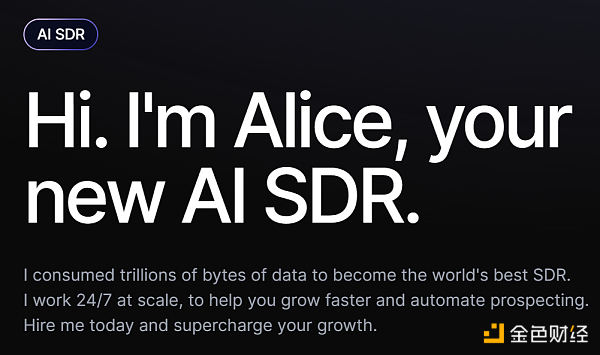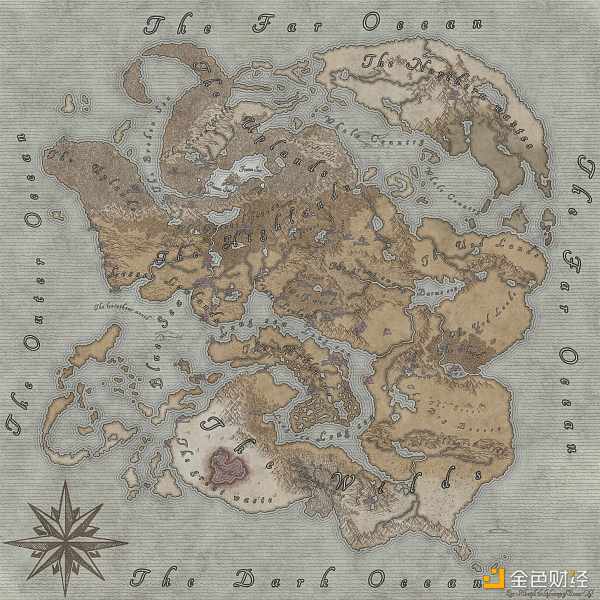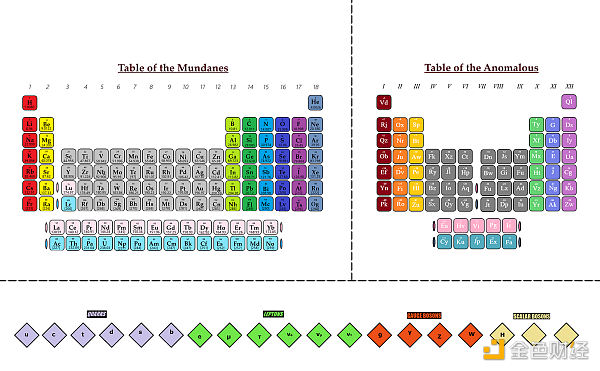Author: CHAO WANG, Crypto4
“Autonomous” – translated into Chinese as “自主” and often translated as “自治”. This is a very important word in my study and work over the past few years. It represents the “A” in DAO and the concept of autonomous world, and also represents people’s expectations for artificial intelligence – autonomous agents.
As a new direction, there are naturally significant differences in everyone’s understanding of autonomous. What exactly is autonomous? Does the meaning of autonomous differ in different fields? Does absolute autonomy exist?
Today, I dare to dissect the past and present of this word.
- Instadapp The Ultimate Aggregator in DeFi
- EigenLayer Trust Revolution with the Introduction of Middleware for Re-staking
- a16z Founder Why is the emergence of blockchain so important when looking back at the history of Internet development?
Autonomous – evolved from the combination of two Greek words, “Auto” and “Normos”. “Auto” in Greek means “self”, while “Normos” comes from the Latin word “Norma”, a carpenter’s square.
 Norma
Norma
This word was later extended to the concept of “law/customs”, and the English word “Norm” comes from this.
In the original meaning in ancient Greece, “autonomous” referred to having the right to self-governance, to establish one’s own laws and not be controlled by larger governing bodies.
Ancient Greece was not a unified nation like modern states. It consisted of numerous city-states (polis), each of which was an independent political entity with its own governance structure, laws, and customs. Different city-states had different forms of government, for example, Athens was a democracy, while Sparta was a mixture of oligarchy and monarchy, and they often competed or conflicted with each other. The word autonomy originated from this period, reflecting the desire of these city-states and their citizens to maintain their unique identities, governance structures, and ways of life in a decentralized and competitive environment.
Over time, the concept of autonomy began to be applied to individuals, referring to the ability of individuals to act according to their own principles or beliefs. The book “Sovereign Individual”, which is regarded as a classic in the crypto community, extensively explores the topic of individual autonomy from economic autonomy, technological empowerment, and other perspectives.
As technology continues to advance, the term “autonomous” has taken on a new meaning – “machines or systems that can operate without direct human intervention or external control”. Today, “autonomous” is often associated with technology, such as autonomous driving systems. These systems operate autonomously, without the need for continuous human supervision. This modern interpretation still carries the core idea of “self-governance”, but its background has far exceeded the imagination of the ancient Greeks.
The changing meanings of the word “autonomous” demonstrate how culture, technology, and society shape and change the public’s perception.
Autonomy in AI
In the field of artificial intelligence, the term “autonomous” usually refers to systems that can perform tasks without human intervention.
Take the ordering scenario as an example. Chatbots like ChatGPT can provide users with a lot of reference information, such as calorie calculation, dish and restaurant recommendations, but they cannot complete the ordering process.
On the other hand, an agent can complete the ordering process according to the user’s instructions, such as “reserve two seats tonight at the Blue Frog restaurant in Guomao on Meituan”. However, the agent needs a prerequisite to complete this task – a pre-designed ordering workflow and integration with Meituan’s services. If the programmer hasn’t written how the agent can place an order or how to integrate with Meituan, the agent will be powerless in the face of this instruction.
An autonomous agent has increased autonomy compared to a regular agent, manifested in stronger thinking ability and more general action ability. When a user says “reserve two quieter seats near Guomao tonight”, the autonomous agent will understand the user’s intention, think about how to act, and execute it. The programmer does not need to pre-teach the agent how to place an order, book a flight, or buy something on eBay. It will act within a general framework based on its understanding of the world and the general rules of online interaction, completing tasks autonomously.
To some extent, all the robots we see in science fiction movies are autonomous agents. For more scenarios and thoughts on autonomous agents, you can refer to the article “From J.A.R.V.I.S. to Westworld – The Future of Symbiosis between Intelligent Agents and Humans”.
Although the meaning of “autonomous” in the AI community does not have much disagreement, there are still significant differences in people’s expectations of autonomous agents. In the field of autonomous driving, there is a classification system, ranging from Level 0, which is completely manual driving, to Level 5, which is fully autonomous driving. This classification also has strong reference value for autonomous agents.

Microsoft’s autonomous agents use a director (surprisingly, Microsoft has such a position) who has stated that “autonomous” means human-like action and decision-making. Microsoft focuses on allowing autonomous agents to solve a specific part of the existing workflow in enterprises. From a technological perspective, this is a very practical choice. However, the degree of autonomy achieved is at most Level 2 or Level 2.5.
Startups in the direction of autonomous agents have greater ambitions. They hope to fully replace humans in many scenarios, such as AI sales representatives. In terms of corresponding levels, this would at least reach Level 3 and Level 4.

A startup project that provides AI sales representative services
As an observer who enjoys watching the excitement, I have higher expectations for the autonomy of intelligent agents.
Imagine a future where my daily work and life rely heavily on the assistance of autonomous agents. One morning, when I call an autonomous agent and suddenly find no response, I check and discover that the hosted Amazon cloud service has malfunctioned. As capable as it may be, it’s unacceptable for it to go offline with just a pull of the plug. A more autonomous intelligent agent should not only have the ability to think and make decisions, but also the ability to operate stably for a long time without human intervention. It should not be easily disconnected by pulling the plug. This will be the basic requirement for autonomous agents as entities with stronger behavioral abilities. And as such, they should have digital identities, a certain degree of autonomous finance, and even control over their own computing power and energy management.
In my opinion, this will be one of the natural convergence points between encryption and AI. If there is a place in the world that can provide a secure and reliable operating environment, and provide an independent and easy-to-operate financial system instead of relying on an institution to approve and close bank accounts at any time, and most applications in this world provide permissionless access and convenient operability. There is no reason for autonomous agents not to choose such an environment to settle. In other words, the future of the encrypted network is the infrastructure for AI to achieve high-level autonomy.
Autonomy in DAO
Compared to AI, there is a greater divergence in understanding the concept of autonomy in DAO.
Although the concept of DAO predates the birth of blockchain systems, the first formal presentation and clear definition of DAO as a concept was in the initial version of the Ethereum whitepaper. Vitalik classified decentralized organizations into two types in the whitepaper, DO (decentralized organization) and DAO (decentralized autonomous organization). Autonomous refers to organizations that rely entirely on code deployed in smart contracts to achieve continuous and interference-free autonomous operation.
In the future, more advanced mechanisms for organizational governance may be implemented; it is at this point that a decentralized organization (DO) can start to be described as a decentralized autonomous organization (DAO). The difference between a DO and a DAO is fuzzy, but the general dividing line is whether the governance is generally carried out via a political-like process or an “automatic” process.
Ethereum Whitepaper, December 2014 version
However, the world is complex. Encryption technology has brought about more efficient and fair distribution of ownership, and has brought stronger coordination capabilities. Communities of different cultures and interests have begun to use these technologies for organization and collective action. Although participants in the encryption field generally agree with the concept of “code is law,” how much business logic can actually run in smart contracts in such a complex world? It was impossible for a long time to expect a set of smart contract code to handle all the work of an organization and to continue to operate automatically.
If we go by the definition of the initial version of the Ethereum whitepaper, none of the current DAOs can be considered DAOs.
The world is constantly evolving. The term “autonomous” has undergone a transformation from self-governance to automated governance in the real world, and then a reverse transformation in the encrypted world.
Starting from reality, many DAO operators no longer insist on pursuing completely code-based full autonomy, but give more space to the social layer. The meaning of autonomy has returned from automated governance to the autonomous governance of the organization. It may also be because such non-automated DAOs are the mainstream supported by current technology. The Ethereum whitepaper also removed the concept of DO in a subsequent update, further blurring the definition of autonomy in DAOs. And with the popularity of the concept of network state in the past two years, autonomy in DAOs has increasingly resembled its meaning when it was born in ancient Greece.
If you ask me, it’s not that important how to understand and practice this concept of “Autonomous”. The original definition of DAO represents an ideal, an expectation of empowering technology. Although it may not be achievable at present, it is a beautiful and pure pursuit.
Nowadays, there are already hundreds and thousands of DAOs that sacrifice technical robustness and make up for it with cultural layers. They bring together community members with shared values and use blockchain technology for more powerful coordination, incentives, and ownership distribution, thereby creating many patterns and achievements that were previously non-existent in the world. This is also the fortune of the times.
In the past, my view was that as encryption technology develops and infrastructure improves, DAOs will gradually reduce their reliance on humans. Today, we may still be using Gnosis’ manual multi-signature method to manage community treasuries, but tomorrow we may automate fund allocation by integrating proposal systems and treasury systems. The day after tomorrow, we may put the roles in DAO on the chain in a certain way, achieving automation of key role assignment. The automation system gradually erodes human roles, and finally, at some point in time, DAO transitions from being human-dependent to being completely code-dependent.
However, as I observe more projects and the development changes of different DAOs over the years, I have come to believe that the current community DAOs and the envisioned DAOs that run automatically should be fundamentally different species. They will take completely different paths in the future, instead of merging into one at a certain point in time.
The human-centric DAO does have a lot of room for improvement in terms of automation to improve efficiency, coordination, and trust. But its value creation entity is always the community, every individual within the community. Humans will always be important.
On the other hand, the envisioned DAO that relies completely on code may have a different starting point, such as an autonomous world.
The Autonomy in the Autonomous World
The Autonomous World, often abbreviated as “AW”, is a concept first proposed by 0xLianGuaiRC in 2022. After a year of fermentation, it has started to receive more and more discussions. The Autonomous World is a relatively complex concept, and many people see it as a concept in the direction of full-chain games, but I don’t think so. It is a crossroads of technology, culture, politics, philosophy, and other fields.
In the concept of the Autonomous World, the world does not specifically refer to the place where human life exists, but is a container, a place that contains rules and narratives. The world where human beings live is, of course, a world, but “The Three-Body Problem” is also a world that exists in books, Bilibili, Tencent Video, and people’s minds. “Chinese Paladin” and “The Lord of the Rings” are also worlds. The world is not necessarily related to stories. For example, chemistry can also be considered a world. It also provides a container and has its own rules.
The world exists in more places. There is a subreddit called worldbuilding on Reddit, and I like to check it out from time to time to see what everyone is talking about. There are many people who tirelessly imagine the geography, climate, history, legends, culture, society, technology, and biological chain backgrounds of a world.
 A constructed world
A constructed world
 Some even construct the ocean currents in their imaginary world
Some even construct the ocean currents in their imaginary world
 Some people have designed a set of dark elemental periodic table for their imagined world
Some people have designed a set of dark elemental periodic table for their imagined world
 Translation: I am a perfectionist and also a world builder. This means that I create my world flawlessly and don’t let any doubt slip in. In my world, I have a history of 2000 years that is unfinished, including wars, blood feuds, detailed events about how certain countries declined, a list of monarchs of an empire, regional explorations, and more. Start with a timeframe and something you like, and then expand it to create your history. I have been doing this for years, but I have only completed about 300 years of history.
Translation: I am a perfectionist and also a world builder. This means that I create my world flawlessly and don’t let any doubt slip in. In my world, I have a history of 2000 years that is unfinished, including wars, blood feuds, detailed events about how certain countries declined, a list of monarchs of an empire, regional explorations, and more. Start with a timeframe and something you like, and then expand it to create your history. I have been doing this for years, but I have only completed about 300 years of history.
After briefly summarizing the concept of the world, let’s take a look at what an autonomous world is. In terms of definition, 0xLianGuairc believes that an autonomous world is a “world with a blockchain underlying layer”. More specifically –
Autonomous Worlds have hard diegetic boundaries, formalised introduction rules, and no need for privileged individuals to keep the World alive.
自主世界有着严格的叙事边界、正式化的引入规则,它不需要特权个体来维持其存在。
Ludens(0xLianGuaiRC)
This sentence describes the three core characteristics of “autonomous worlds”:
Hard diegetic boundaries: This means that the world has a set of fixed and immutable baseline rules. They do not change with time or circumstances, providing stability to the world.
Formalised introduction rules: This indicates that there are clear and fixed rules for entering and participating in this world. These rules include how to become part of this world and how to interact within it.
No need for privileged individuals to keep the world alive: This world is self-sustaining and does not rely on any specific individuals or organizations to maintain or manage it.
From this perspective, an Autonomous World is closer to the original definition of a DAO – autonomously operating under preset rules, without relying on any individual or soft rules or political coordination processes. In other words, a DAO itself is a form of an autonomous world.
What is the charm of such a self-contained world? I believe it is objectivity.
The real world we live in is objective. No one owns this world, and it does not exist because of any individual or organization. The fundamental laws that maintain the existence and operation of this world are physical laws. Everyone can exert influence on this world under the agreement of physical laws and make this influence a objective fact in this world.
But the world of “Harry Potter” is not objective. If J.K. Rowling added another character when writing, this character would become a part of the world. If she didn’t write it, it wouldn’t exist. This world is constructed by J.K. Rowling and depends on J.K. Rowling to maintain its rules. Thousands of fans can read it, love it, but cannot change it, cannot go to the platform of platform 9¾ and leave their own backpack to make it a “existence” in this world.
“World of Warcraft” is also not objective. Although people can enter this world and interact and influence the “objective facts” in this world under the rules set by Blizzard, “World of Warcraft” essentially depends on the subjective will of Blizzard and its managers. When the cooperation between Netease and Blizzard broke last year, all the “objective existence” created by Chinese players also disappeared.
But now, we have the opportunity to create a self-contained, objective world based on blockchain network. In such a self-contained world, everything created by people becomes objective facts, objective facts in a world with stable rules and self-sustaining.
The above summarizes the concept of “Autonomous” and its underlying logic in several different fields. It is only my personal thinking and may not be all correct. And the meaning of “Autonomous” is still evolving. “Autonomy” is one of the most profound topics in human civilization, far beyond what can be covered in this short article.
Over the past week, I read a science fiction novel called “Blindsight”. This is a book that had to be published for free on the Internet after being rejected by major publishers. It is regarded as a masterpiece by many, but also as garbage by many. The author’s other identity is a marine biologist. The academic expression and not so smooth writing style made the reading experience unpleasant. What supported me to finish reading it was a viewpoint proposed in the novel – is it possible that the self-consciousness that humans are proud of is actually a shackle that limits human development? The author’s thinking here is wise and thought-provoking.
From this thinking, let’s jump to another long-debated topic – are humans autonomous? Has everything that happens in the world already been defined by higher-dimensional code?
We pursue autonomy in this world, but can we really break free from the constraints of cosmic smart contracts?
Like what you're reading? Subscribe to our top stories.
We will continue to update Gambling Chain; if you have any questions or suggestions, please contact us!